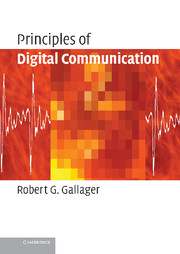Book contents
- Frontmatter
- Contents
- Preface
- Acknowledgements
- 1 Introduction to digital communication
- 2 Coding for discrete sources
- 3 Quantization
- 4 Source and channel waveforms
- 5 Vector spaces and signal space
- 6 Channels, modulation, and demodulation
- 7 Random processes and noise
- 8 Detection, coding, and decoding
- 9 Wireless digital communication
- References
- Index
1 - Introduction to digital communication
Published online by Cambridge University Press: 05 June 2012
- Frontmatter
- Contents
- Preface
- Acknowledgements
- 1 Introduction to digital communication
- 2 Coding for discrete sources
- 3 Quantization
- 4 Source and channel waveforms
- 5 Vector spaces and signal space
- 6 Channels, modulation, and demodulation
- 7 Random processes and noise
- 8 Detection, coding, and decoding
- 9 Wireless digital communication
- References
- Index
Summary
Communication has been one of the deepest needs of the human race throughout recorded history. It is essential to forming social unions, to educating the young, and to expressing a myriad of emotions and needs. Good communication is central to a civilized society.
The various communication disciplines in engineering have the purpose of providing technological aids to human communication. One could view the smoke signals and drum rolls of primitive societies as being technological aids to communication, but communication technology as we view it today became important with telegraphy, then telephony, then video, then computer communication, and today the amazing mixture of all of these in inexpensive, small portable devices.
Initially these technologies were developed as separate networks and were viewed as having little in common. As these networks grew, however, the fact that all parts of a given network had to work together, coupled with the fact that different components were developed at different times using different design methodologies, caused an increased focus on the underlying principles and architectural understanding required for continued system evolution.
This need for basic principles was probably best understood at American Telephone and Telegraph (AT&T), where Bell Laboratories was created as the research and development arm of AT&T. The Math Center at Bell Labs became the predominant center for communication research in the world, and held that position until quite recently.
- Type
- Chapter
- Information
- Principles of Digital Communication , pp. 1 - 15Publisher: Cambridge University PressPrint publication year: 2008



